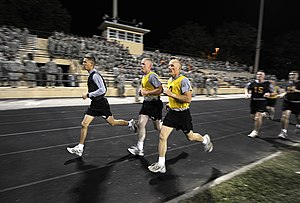
Research Paper Title
An Alternative Approach to the Army Physical Fitness Test Two-mile Run using Critical Velocity and Isoperformance Curves.
Background
The purpose of this study was to evaluate the use of critical velocity (CV) and isoperformance curves as an alternative to the Army Physical Fitness Test (APFT) two-mile running test.
Methods
Seventy-eight men and women (mean +/- SE; age: 22.1 +/- 0.34 years; VO2(MAX): 46.1 +/- 0.82 mL/kg/min) volunteered to participate in this study. A VO2(MAX) test and four treadmill running bouts to exhaustion at varying intensities were completed. The relationship between total distance and time-to-exhaustion was tracked for each exhaustive run to determine CV and anaerobic running capacity. A VO2(MAX) prediction equation (Coefficient of determination: 0.805; Standard error of the estimate: 3.2377 mL/kg/min) was developed using these variables. Isoperformance curves were constructed for men and women to correspond with two-mile run times from APFT standards. Individual CV and anaerobic running capacity values were plotted and compared to isoperformance curves for APFT 2-mile run scores.
Results
Fifty-four individuals were determined to receive passing scores from this assessment. Physiological profiles identified from this procedure can be used to assess specific aerobic or anaerobic training needs. With the use of time-to-exhaustion as opposed to a time-trial format used in the two-mile run test, pacing strategies may be limited.
Conclusions
The combination of variables from the CV test and isoperformance curves provides an alternative to standardised time-trial testing.
Reference
Fukuda, D.H., Smith, A.E., Kendall, K.L., Cramer, J.T. & Stout, J.R. (2012) An Alternative Approach to the Army Physical Fitness Test Two-mile Run using Critical Velocity and Isoperformance Curves. Military Medicine. 177(2), pp.145-151.

